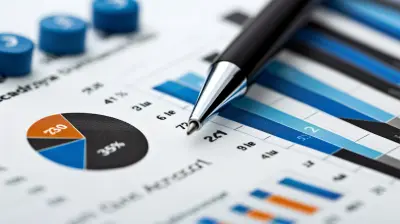Emerging Product Development Trends You Can’t Ignore
9 July 2025
In today’s lightning-fast world, product development isn’t what it used to be. What worked ten years ago might already be a museum piece. The game has changed—radically. If you're in product development or even thinking about dipping your toe in the water, you need to be on top of the latest trends or risk becoming irrelevant.
Let’s face it: the marketplace is crowded. Standing out means building products that not only solve real problems but also keep up with ever-shifting customer expectations, technology, and industry demands. So, what are the emerging product development trends you absolutely can’t afford to ignore? Buckle up—we're diving in.
Why Product Development is Evolving So Rapidly
Before we jump into the trends, let's get one thing straight—why is product development moving at warp speed?Thanks to digital transformation, consumer behavior is evolving faster than ever. People are more informed, more connected, and frankly, more impatient. They want solutions yesterday. Technology like AI, machine learning, and IoT are flipping entire industries on their heads.
Add in the remote work revolution, global competition, sustainability concerns, and—bam! It’s a perfect cocktail for change.
1. Customer-Centric Design is Taking the Wheel 🚗
Gone are the days when companies built products and hoped people would buy them. Now, it's all about building with the user in mind from day one.What does that mean for you?
You need to know your customer like your best friend. Their pain points, wants, needs, and even their pet peeves. Companies are tapping into user data, conducting UX research, and iterating designs based on real-time feedback.Personalization, empathy mapping, and user journey optimization are no longer optional—they’re essential.
> Think of your product as a custom-tailored suit. You wouldn’t wear pants two sizes too big, right? Same goes for your users.
2. Agile and Lean Product Development Is the New Normal
Let’s be honest—traditional development models can be sloooow. In this age of speed, being agile isn’t just trendy—it’s survival.Agile and lean methodologies allow teams to move faster, adjust quickly, and minimize waste. They’re all about short development cycles (sprints), constant feedback, and incremental improvements.
Why should you care?
It means you can launch faster, test smarter, and adapt better. Building a minimum viable product (MVP) and iterating based on real-world results isn’t just cost-effective—it’s incredibly efficient.> Remember: Done is better than perfect. Get it out there, then improve it.
3. Artificial Intelligence Isn’t Just Buzz—It’s a Strategic Weapon
AI isn’t sci-fi anymore. It’s your new best friend in product development.From automating repetitive tasks to predicting customer behavior, AI tools are making development smarter and faster. Machine learning can identify patterns human eyes might miss. AI-driven analytics can steer your product roadmap with terrifying accuracy.
Voice assistants, chatbots, personalization engines—you name it. AI is already deeply embedded in the most successful products out there.
Don't fall behind. Tap into AI for everything from ideation to post-launch performance tracking.
4. The Rise of No-Code and Low-Code Platforms
Think you need a computer science degree to build a killer product? Think again.No-code and low-code platforms are lowering the barrier for innovation. Whether you're launching an app, building a marketplace, or creating internal tools—there’s a platform that lets you drag, drop, and deliver.
Why is this huge?
Speed and accessibility. Teams without a tech background can now prototype and build at lightning speed, putting more power in the hands of marketers, designers, and entrepreneurs.> It's like handing everyone a Swiss Army knife. The possibilities? Endless.
5. Sustainability is No Longer Optional 🌱
Eco-conscious consumers are more vocal—and powerful—than ever. If your product isn’t sustainable, it’s going to raise red flags.Whether it’s using eco-friendly materials, ensuring ethical sourcing, or having a clear recycling process—sustainability matters.
Companies integrating circular economy principles are not only saving the planet but also winning serious brand loyalty.
Tip:
Make sustainability part of your core product strategy, not just a marketing blurb. Transparency and authenticity go a long way.6. Cross-Functional Teams Are Fueling Innovation
Product development isn't a solo act anymore. It's more like a band—with marketing, engineering, design, and sales all playing in harmony.Having cross-functional teams means faster feedback, richer perspectives, and smoother execution.
These teams break down silos and encourage collaboration, which results in more innovative and user-aligned products.
> Imagine trying to build a spaceship with just a screwdriver. You need the full toolbox, folks.
7. Data-Driven Decision-Making Is the Name of the Game 📊
Flying blind is no longer an option.Modern product development is rooted in data—from user analytics and engagement metrics to A/B testing and heatmaps. Insights from real usage should guide everything from feature prioritization to UI tweaks.
What’s the magic formula?
- Collect data- Analyze it meaningfully
- Act fast
Use tools like Google Analytics, Mixpanel, and Hotjar to dig deep into how users interact with your product.
8. Inclusion and Accessibility Are Front and Center
Your product should work for everyone—not just a select few.Accessibility isn’t just about compliance anymore. It's about creating inclusive experiences that respect diversity in age, ability, culture, and more.
Products that prioritize accessibility from the start are not only socially responsible—they also tap into a larger market.
> Think of accessibility like curb cuts. Originally designed for wheelchairs, they help everyone—from parents with strollers to delivery workers.
9. Continuous Discovery is Fueling Breakthroughs 🔍
Building is just one half of the equation. The other half? Discovering what to build next.Continuous discovery involves talking to users regularly, exploring market shifts, and staying curious. It requires a mindset shift from “build it and they will come” to “listen first, then build.”
Use interviews, usability tests, and even customer advisory boards to keep your finger on the pulse.
10. The Future Is Remote and Global
Remote work is here to stay, and product teams are becoming more distributed. That means tapping into talent across time zones—and building tools and cultures that support remote innovation.Add to that the global market perspective. Even if you're launching locally now, thinking globally from day one can future-proof your product.
Translation? Flexible communication, asynchronous collaboration tools, and a deep understanding of international markets are must-haves.
11. Blockchain Technology is Gaining Product-Market Fit
Blockchain isn't just for crypto nerds anymore.Decentralized apps (dApps), smart contracts, and transparent supply chains are making waves in industries from finance to healthcare. If you can identify a real-world problem that blockchain solves—boom, you've got gold.
While full implementation might not be right for all products, understanding how blockchain can add value puts you one step ahead.
12. Immersive Technologies: AR, VR, and Beyond
Want to dazzle your users? Mixed reality is where it's at.Augmented Reality (AR) and Virtual Reality (VR) are evolving from gaming gimmicks to real tools in education, retail, property, and even fitness. As hardware becomes more accessible, integrating immersive tech into your product could be a game-changer.
> Think of it as stepping into the internet instead of just browsing it.
13. Hyper-Personalization via Predictive Analytics
Today's users expect more than just good UX—they want a tailored experience every time they interact with your product.Thanks to predictive analytics and user profiling, your product can deliver just that—recommending features, content, offers, or workflows based on user behavior.
No two user journeys will be exactly the same—and that’s the whole point.
14. Ethical Innovation: Building With Purpose
Last but definitely not least: today’s most successful products aren’t just useful—they stand for something.Ethical innovation focuses on doing right by people, communities, and the planet. Whether it's data privacy, fair labor, or digital wellbeing, people care deeply about how products are made and what they represent.
If you’re building something impactful, let purpose be your north star. It’s the ultimate competitive edge.
Final Thoughts: The Future Is What You Build Today
Let’s wrap this up with some real talk.Product development is no longer about building the next big thing—it's about building the right thing, in the right way, for the right people.
These emerging trends aren’t optional upgrades. They’re the new foundations. If you want your product to thrive in 2024 and beyond, it’s time to take these seriously. Learn about them. Embrace them. Start experimenting today.
Because here's the truth: The future belongs to the builders who adapt.
So, are you ready to roll up your sleeves and build something incredible?
all images in this post were generated using AI tools
Category:
Product DevelopmentAuthor:

Matthew Scott
Discussion
rate this article
1 comments
Alice Moore
What an insightful read! 🌟 It’s exciting to see how these emerging product development trends can transform our industry. Embracing innovation and adaptability will surely lead to greater success. Let’s stay ahead of the curve and create amazing products together! 🚀
July 26, 2025 at 12:04 PM

Matthew Scott
Thank you! I’m glad you found it insightful. Excited to see how we can leverage these trends together! 🚀


